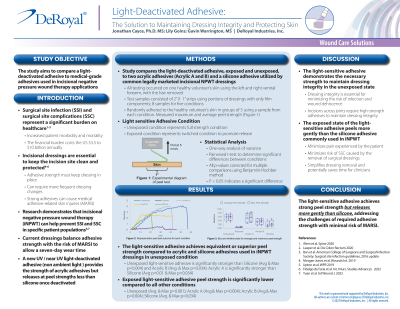Laboratory Research
(LR-005) Light-Deactivated Adhesive: The Solution to Maintaining Dressing Integrity and Protecting Skin
Friday, April 28, 2023
7:15 PM - 8:30 PM East Coast USA Time

Lily Goins, A.S. – Engineering Technician, Engineering, DeRoyal Industries; Gavin Warrington, M.S. – Project Engineer, Engineering, DeRoyal Industries
Introduction: Surgeons take extra precautions to protect against Surgical Site Infections (SSIs) and Surgical Site Complications (SSCs) by using incisional negative pressure therapy (iNPWT). Surgeons use iNPWT over joints or other areas of the body subjected to forces that stress the adhesive of the dressing. Most dressings use strong acrylic adhesives to keep the dressing in place but can cause medical adhesive-related skin injuries (MARSI)1,2. Surgeons need an incisional dressing that balances dressing security and protects healthy skin. A new light-deactivated adhesive supplies strength but releases when exposed to a specific wavelength of light. This research compares the light-deactivated adhesive to acrylic and silicone adhesives used in incisional dressings.
Methods: The study used peel strength testing to compare the light-deactivated adhesive to two acrylic adhesives and a silicone adhesive. Testing required one-by-two-inch samples obtained from iNPWT dressings or sheets of transparent film dressings. The light-deactivated adhesive had two groups, unexposed and exposed. Researchers randomly adhered the samples in groups of six on a healthy volunteer's ventral forearm using 1 inch of the sample. They secured the second half with a clamp on a universal testing machine. The universal testing machine pulled each sample at a 90° angle at 5 mm per second. The results report the average maximum peel strength (Newtons) and 95% confidence interval. Statistical analysis used a one-way analysis of variance followed by paired-wise t-tests. Reported p-values underwent adjustment using the Benjamini-Hochberg method for multiple comparisons. A p-value of less than 0.05 indicates a significant difference.
Results: Unexposed light-deactivated adhesive exhibited an average maximum peel strength of 2.92+/-0.72 N compared to Acrylic A 2.81+/-0.96 N, Acrylic B 1.81+/-0.62 N, and Silicone 1.19+/-0.64 N. Exposed light-deactivated adhesive decreased in average maximum peel strength to 0.30+/-0.14 N. The ANOVA indicated a significant difference (p=3.19E-06). Pairwise testing found that the exposed light-deactivated adhesive had a significantly lower peel strength than all other conditions (p-value range: 0.0008 - 0.0492). The unexposed light-deactivated adhesive had significantly higher peel strength than silicone (p=0.005) and acrylic B (p=0.0492). All other comparisons showed no difference.
Discussion: The study results show a profound decrease in peel strength in the exposed light-deactivated adhesive compared to its unexposed state. Using the light-deactivated adhesive in surgical and other wound care dressings will help to address challenges in securing a dressing while preventing MARSI.
Methods: The study used peel strength testing to compare the light-deactivated adhesive to two acrylic adhesives and a silicone adhesive. Testing required one-by-two-inch samples obtained from iNPWT dressings or sheets of transparent film dressings. The light-deactivated adhesive had two groups, unexposed and exposed. Researchers randomly adhered the samples in groups of six on a healthy volunteer's ventral forearm using 1 inch of the sample. They secured the second half with a clamp on a universal testing machine. The universal testing machine pulled each sample at a 90° angle at 5 mm per second. The results report the average maximum peel strength (Newtons) and 95% confidence interval. Statistical analysis used a one-way analysis of variance followed by paired-wise t-tests. Reported p-values underwent adjustment using the Benjamini-Hochberg method for multiple comparisons. A p-value of less than 0.05 indicates a significant difference.
Results: Unexposed light-deactivated adhesive exhibited an average maximum peel strength of 2.92+/-0.72 N compared to Acrylic A 2.81+/-0.96 N, Acrylic B 1.81+/-0.62 N, and Silicone 1.19+/-0.64 N. Exposed light-deactivated adhesive decreased in average maximum peel strength to 0.30+/-0.14 N. The ANOVA indicated a significant difference (p=3.19E-06). Pairwise testing found that the exposed light-deactivated adhesive had a significantly lower peel strength than all other conditions (p-value range: 0.0008 - 0.0492). The unexposed light-deactivated adhesive had significantly higher peel strength than silicone (p=0.005) and acrylic B (p=0.0492). All other comparisons showed no difference.
Discussion: The study results show a profound decrease in peel strength in the exposed light-deactivated adhesive compared to its unexposed state. Using the light-deactivated adhesive in surgical and other wound care dressings will help to address challenges in securing a dressing while preventing MARSI.

.png)